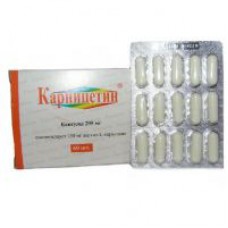Expiration date: 07/2026
The composition and form of issue:
Capsules. 1 capsule contains active substance:
of acetyl-l-carnitine hydrochloride (Carnitin) 0, 295 g
(corresponding to 0, 25 g of acetyl-l-carnitine)
other ingredients: microcrystalline cellulose silicon dioxide colloidal (Aerosil A-300) magnesium stearate from the mass of the capsule 0, 34 g
hard gelatin capsules
(composition capsules: gelatin, glycerol (glycerin), nipagin (methyl parahydroxybenzoate), nipazol (parahydroxybenzoate), sodium lauryl sulfate, purified water, titanium dioxide)
in banks polymer with lids 60 pieces in the paper cartons 1 Bank or in a contour acheikova packing 10 or 15 PCs in cardboard pack 6 or 4 packs, respectively.
Description pharmaceutical form:
The contents of capsules — powder from white to white with a yellowish sheen color with a faint odor of acetic acid. Capsules white color number 0.
Pharmacokinetics:
In animal studies after oral administration (500 mg/kg) Cmax in the blood occurs within 4 h and is 40 µm/l for 8 h. the Absorption of acetyl-L-carnitine (ALC) from the gastrointestinal tract occurs due to active transport or by simple diffusion through the mucosa (under the condition of high concentration). In most tissues, including cerebral, ALA, comes from the blood stream (with the exception of liver and small intestine) in an unmodified form. In the cage of ALK is generated through a direct energy-dependent process against a concentration gradient. Excreted by the kidneys.
Description pharmacological action:
Acetyl-L-carnitine (ALC), a natural biologically active substance under physiological conditions is present in the body in various organs and tissues, including the CNS, is involved in the metabolism of fatty acids and carbohydrates. Pharmacological and biological activity of ALK is largely due to the metabolic effects of L - carnitine and acetyl groups, included in its composition. Acetyl-L-carnitine (ALC), the biologically active form of L-carnitine, a key substance in the process of catabolism of fats and the production of energy in the body. ALA is synthesized in brain tissue, the liver and kidneys from L-carnitine when the enzyme Karntnerstrasse. Since ALK supplies an activated acetate directly in the matrix of the mitochondria for the formation of acetyl-COA that participates in the tricarboxylic acid cycle, without additional expenditure of energy, it is a readily available substrate for the launch of energy-dependent metabolic processes in the mitochondria. Through the complete energy supply of the body with less oxygen consumption by the tissues ALA protects brain tissue from ischemia.
Due to its structural similarity to acetylcholine, ALC exerts a cholinomimetic effect, and also exhibits neuroprotective properties. It increases the cellular concentration of aspartic acid, glutamic acid, and taurine, prolonged use increases the density of N-methyl-D-aspartate receptors in the hippocampus, cortex and striatum and prevents a decrease in their density in terms of aging. ALA enhances the effects of serotonin, and protects brain cells from the neurotoxic effects of ammonia and glutamate.
The results of experimental studies showed that ALK has posed anti-amnesic activity, the ability to improve learning processes, indicators of non-associative memory to have a positive effect on mnestic functions in experimental models of Alzheimer's disease, without causing side effects sedative and muscle relaxant nature.
ALA increases the production of energy, being readily available substrate for the launch of energy-dependent metabolic processes in the mitochondria. Stimulates the synthesis of proteins and phospholipids for building membranes, improves regeneration processes. In pathology has a neuroprotective effect, especially in relation to neurons and their organelles (mitochondria), as well as neurotrophic effect by modulating the activity of nerve growth factor (NGF). Has antioxidant and membrane stabilizing effect. ALA may accelerate the regeneration of nerve cells and endocrine traumatic injuries of peripheral nerves in experimental models of polyneuropathy in diabetes.
Noticeable effect ALA has on slowing the aging process by increasing the transport of fatty acids into the mitochondria and maintain their level of younger organism. ALA may accelerate the regeneration of nerve cells and endocrine traumatic injuries of peripheral nerves in experimental models of diabetes.
Indications:
- the initial stage of dementia of Alzheimer's type (Alzheimer's disease) and cerebral-vascular dementia
- peripheral neuropathy of various etiology
- primary and secondary involution syndromes on a background of vascular encephalopathy
- decreased mental capacity, to improve concentration attention and memory.
Contraindications:
- individual hypersensitivity to the drug
- the age of 18 years (efficacy and safety not established).
Application of pregnancy and breast-feeding:
Special studies on the possibility of using during pregnancy and breastfeeding have not been conducted used only if the expected benefit to the mother outweighs risk to the fetus. At the time of treatment should stop breastfeeding.
Side effects:
Possible allergic reactions, nausea, heartburn.
Drug interactions:
Cases of drug interactions were not noted.
Method of application and dose:
Inside. Single dose for adults is usually 1-4 caps., the daily dose is 6-12 capsules. The course of treatment is 1-4 months.
Overdose:
Cases of overdose not registered.


